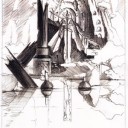神河当時 - フレイバーの資料
2020年7月1日 Magic: The Gathering
『神河物語』のネーミングとフレイバーテキスト担当者の記事です。
初参加は『フィフス・ドーン』、すでに世界が構築されたセットでした。
対照的に、『神河物語』は世界を作るところから参加することになります。そのため、多くの資料を基に、日本の世界を勉強したそうです。
一般書籍『A Popular Dictionary of Shinto』『The Samurai Sourcebook』
黒澤明監督『七人の侍』『乱』『蜘蛛巣城』
宮崎駿監督『千と千尋の神隠し』『もののけ姫』
マンガ・アニメ『獣兵衛忍風帖』『犬夜叉』
などです。
両監督の作品は海外でも人気があります。『獣兵衛忍風帖』『犬夜叉』も、海外で人気だったということでしょうか。寡聞にして知りませんでした。
ネーミングに関する、より詳しい話はこの後取り上げます。
追記
webアーカイブに、日本語訳の記事があるのを発見しました。
一万の伝説の地 ――神河物語の名前とフレイバーの幕裏
https://web.archive.org/web/20041217002944/http://www.hobbyjapan.co.jp/magic/articles/files/20041013_01.html
For a names and flavor text writer, Champions of Kamigawa was a dream come true. Recall that my first set as a creative writer was Fifth Dawn. For Fifth Dawn my goal was to learn as much about the metallic setting of Mirrodin as possible, to stay true to the world-building done in the previous two sets while trying to solve whatever creative puzzles I could find. In many ways, Fifth Dawn was about putting the (hopefully satisfying) finishing touches onto an already-detailed world.
Champions of Kamigawa, in contrast, felt like a blank canvas. The canvas wasn’t blank at all of course, since Brady Dommermuth, Brandon Bozzi, Jeremy Cranford, and the other creative folks at Wizards had done a lot to create a compelling Sengoku-era (late 15th and early 16th century Japan) fantasy setting in which Shinto had gone terribly wrong. By the time I and the other writers arrived on the scene, Kamigawa (initially called “Inrekai”) was already a living, vibrant setting.
But what the creative folks had done was paint broad brushstrokes. They had provided a rendering and asked the artists, novelists, and creative text writers to turn this rendering into a blueprint. We were asked to populate the plane with colorful characters, tragic battles, and a deep history. Kamigawa, as Brandon explained it to us, was a land of ten-thousand legends. It was up to us to tell those legendary stories.
Speaking of “us,” the Champions of Kamigawa names and flavor text writers, in addition to me, Brandon and Brady, were:
Rich Amtower (Video-game writer, editor-for-hire, and self-described "Grammar Hammer")
Doug Beyer (Web Developer for magicthegathering.com and Prismatic enthusiast)
Shelley Bullock (Item-Master Developer and a warehouse of anime and manga knowledge)
Jennifer Clarke-Wilkes (Editor who has been working on Magic creative stuff since 1997)
Rei Nakizawa (Former WotC staff writer and Story Guy Extraordinaire)
Apparently one of these things was not like the others. Namely me. See, I was thrilled to be asked back after my Fifth Dawn experience, but I think I was the only person on the team who wasn’t a “manga” or “anime” guy. That is, at the time I was much more comfortable dealing with fantasy based on western than eastern mythology. I vividly remember reading the Kamigawa cosmology document and having beads of sweat start collecting between my shoulder blades. How could I stay true to a sense of Japanese history and culture when I barely knew either?
Brandon and Brady, thankfully, pointed me to study materials. Over the course of my three months working on the set, I read “Japanese Ghosts and Demons” by Stephen Addiss, “Myths and Legends of Japan” by Davis Hadland, “A Popular Dictionary of Shinto” by Brian Bocking, and “The Samurai Sourcebook; Samurai Warfare” by Stephen Turnbull. Thank goodness for the Public Library. I also watched every movie I could find by Akira Kurosawa (Seven Samurai, Ran, Throne of Blood) and Miyazaki Hayao (Spirited Away, Princess Mononoke) as well as the anime/manga series Ninja Scroll and Inu Yasha. Thank goodness for Netflix too. By the end of Champions of Kamigawa, I think it’s fair to say that a new manga guy had been born.
In my Fifth Dawn article, I described the process of naming cards and writing flavor text. That process was still in place for Champions of Kamigawa so no need to rehash old material. Instead, let’s remember Brandon’s words that Kamigawa is a world of ten-thousand legends. Today I’ll give you some insight into how some of those legends were created, first with the general challenges of flavor text and naming in Champions, then via some specific stuff I wrote.
引用元
LAND OF TEN-THOUSAND LEGENDS Posted in Feature on October 4, 2004
https://magic.wizards.com/en/articles/archive/feature/land-ten-thousand-legends-2004-10-04
初参加は『フィフス・ドーン』、すでに世界が構築されたセットでした。
対照的に、『神河物語』は世界を作るところから参加することになります。そのため、多くの資料を基に、日本の世界を勉強したそうです。
一般書籍『A Popular Dictionary of Shinto』『The Samurai Sourcebook』
黒澤明監督『七人の侍』『乱』『蜘蛛巣城』
宮崎駿監督『千と千尋の神隠し』『もののけ姫』
マンガ・アニメ『獣兵衛忍風帖』『犬夜叉』
などです。
両監督の作品は海外でも人気があります。『獣兵衛忍風帖』『犬夜叉』も、海外で人気だったということでしょうか。寡聞にして知りませんでした。
ネーミングに関する、より詳しい話はこの後取り上げます。
追記
webアーカイブに、日本語訳の記事があるのを発見しました。
一万の伝説の地 ――神河物語の名前とフレイバーの幕裏
https://web.archive.org/web/20041217002944/http://www.hobbyjapan.co.jp/magic/articles/files/20041013_01.html


コメント